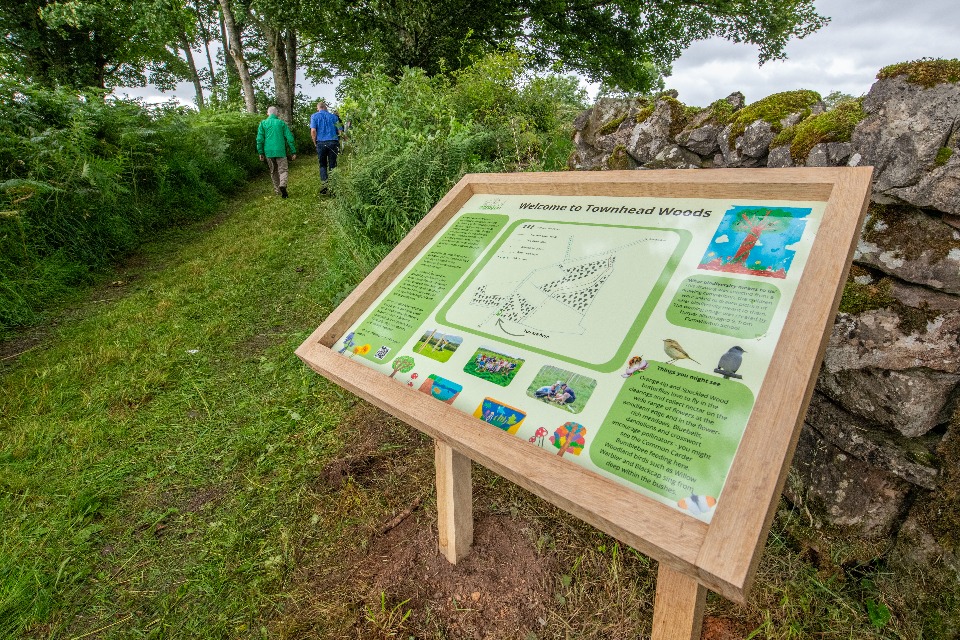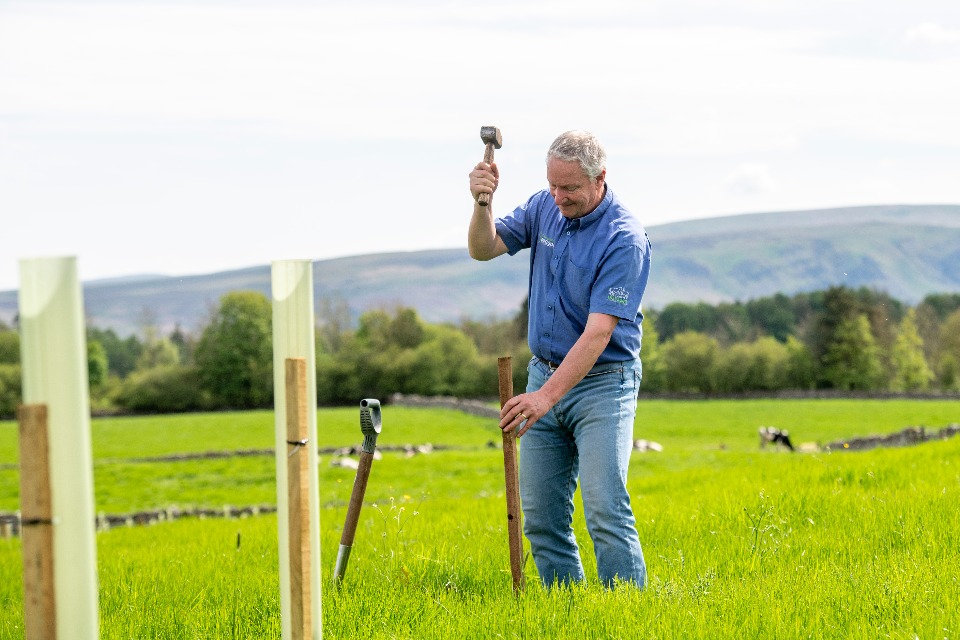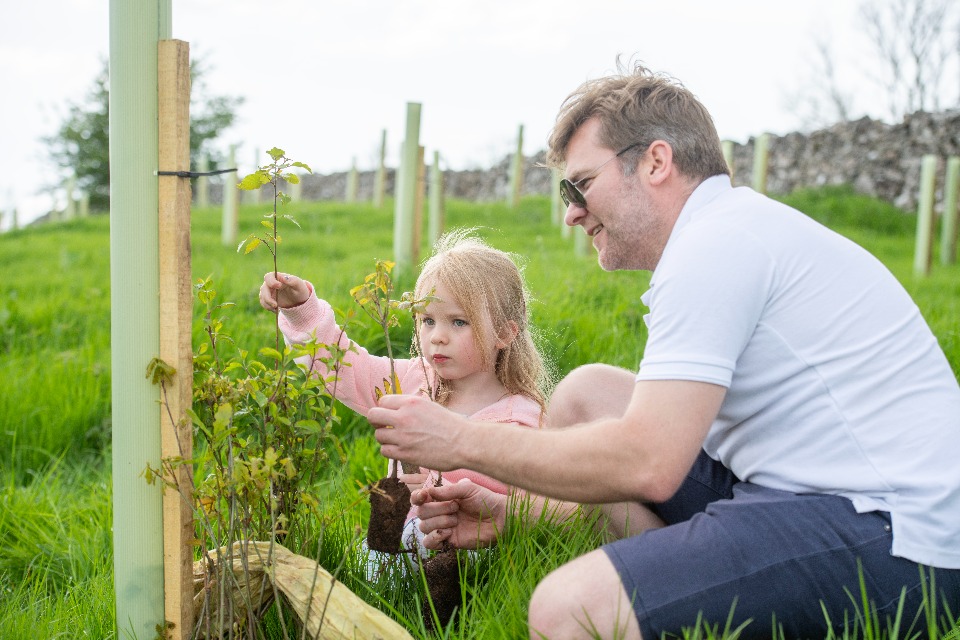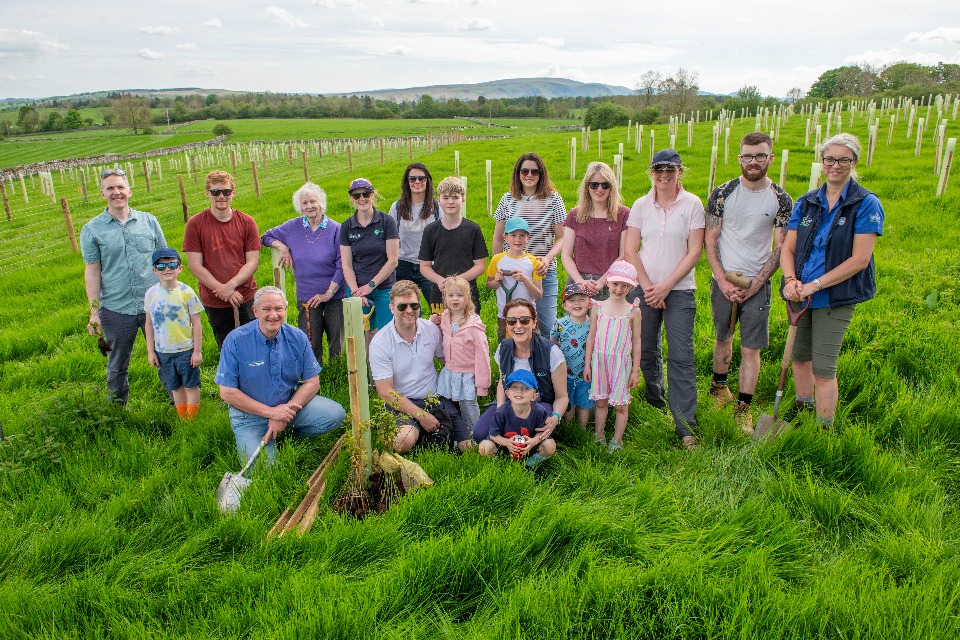Read how Paragon Veterinary Group used the England Woodland Creation Offer to support business sustainability while improving biodiversity to the benefit of the wider community.
Key facts
- site: Townhead Woods, Cumbria
- size: 2.8 hectares
- type: native broadleaf
- species: oak, hornbeam, hazel, rowan, bird cherry, willow and shrubs
- date planted: spring 2024
- grant: England Woodland Creation Offer (EWCO)
Objectives: enhance biodiversity in the area, sequester carbon to offset business emissions, create opportunities for staff, clients and the public to engage with nature and enjoy the site

A new interpretation board marking one of the entrances to Paragon's Townhead Woods. Credit: IntroPR
Planting trees to offset carbon emissions
Paragon Veterinary Group (Paragon) is based in Cumbria. They run a practice three miles outside of Penrith supporting local farmers and the community, looking after farm animals, pets and horses. They are the first veterinary practice to be awarded the Environmental Sustainability Award by the Royal College of Veterinary Surgeons.
The idea of woodland creation began to take root when the practice turned its focus to their sustainability plans and their commitments to becoming carbon neutral by 2030. As part of these aspirations and through doing carbon calculations, they realised they had a fantastic opportunity to plant some of their 13-hectare site with woodland to offset some of their carbon emissions. The new woodland is estimated to offset almost 1,000 tonnes of carbon.
As a veterinary practice, helping animals is a cause that is close to their hearts - making the added biodiversity boost that woodlands can provide a further motivator to move forward with their plan.
Laura Binnie, Vet and Sustainability Champion for the practice, said:
Paragon is becoming a sustainable business, and we want to reduce our impact on the environment. It is really important to us. This wood is part of our sustainability plan, so we're doing our bit for the environment.

A person from Paragon Veterinary Group putting a stake in the ground that will support a tree guard and newly planted sapling. Credit: IntroPR
Turning grant funding into woodland that benefits nature and the community
Paragon found financial support from EWCO for capital items and activities to establish a new woodland appealing as it enabled them to quickly understand what they could claim for when planting and exactly what costs they would get back.
Due to the location and nature of the site, they were eligible for additional contributions, which are one-off payments for the environmental and social benefits provided by a woodland. For Paragon, these included payments for water quality, nature recovery, being close to settlements and for allowing recreational access into the woodland. This made EWCO an attractive offer and the woods were designed accordingly to meet the site's objectives, informed by these eligibilities.
EWCO has helped them to cover some infrastructure costs such as repairing an existing dry-stone wall which will act as part of the woodland perimeter, protecting the growing forest from livestock in the adjoining field.
With a large team at the veterinary practice and the nearby community of Stainton to consider, engagement was top of mind throughout the process. It was decided that 450 metres of path would be included in the design, allowing permissive access for thirty years. The cost of building paths, installing wooden way markers and interpretation signs were covered by the EWCO grant.

Members of the local community helping to plant the new woodland. Credit: IntroPR
Laying the groundwork for a thriving woodland
Paragon started their planning process by choosing the appropriate site. With horse paddocks, hay production and a tenant farmer to consider, they turned their attention to less productive land in their holding. This land was between two other woodland parcels and gave them the opportunity to create a larger wood by connecting and expanding the habitat.
By engaging with a Forestry Commission Woodland Officer early in the process, they learned what additional contributions they could get through EWCO and were signposted to resources that could help with their grant application and planning.
One example was Forest Research's Forest Development Types , which helped them to identify the ideal species mix for a resilient woodland. By understanding factors like soil nutrients and moisture retention, they were able to plan a woodland with an optimal species mix for the landscape that complemented their goals for carbon capture and biodiversity.
The final woodland design featured a mix of resilient broadleaves with rides and open space to allow for butterflies and invertebrates. The location connects to smaller parcels of woods, expanding them and providing wider benefits. With access paths connecting the woods to a public right of way, the local community will also be able to enjoy the benefits of the woodlands.
Navigating the wider environment with care
Using Forester , Forestry Commission's GIS system, Paragon discovered that there are breeding waders around the area they were planning to plant. Working with Natural England and the Forestry Commission, it was determined that the specific planting site had other features that ultimately made it unsuitable for waders to breed and the woodland plans were allowed to continue.
The historic environment was also reviewed with their local county council archaeologist and a land search was carried out. A few features were flagged in neighbouring fields: artefacts from the Penrith Hoard had previously been found in the adjacent field which are now in the British Museum. The planting site was reviewed by a Forestry Commission Historic Advisor who deemed that the proposed woodland would not impact the adjacent archaeological site.
There were also restrictions around land access, with telephone masts and a tenant farmer to consider. However, with careful plans, Paragon was able to utilise nearby commons and planned open space to ensure that access remained possible.

A group photo from one of the community planting days at Paragon's Townhead Woods. Credit: IntroPR
Engaging with the wider community
Local schools and the parish were keen to get involved in the process of creating the woodland. The team at the veterinary practice also got their hands dirty with a family planting day alongside children from the local school. This early engagement has helped to cement the woodland as part of the wider community and the reception has been overwhelmingly positive.
David Black, Senior Director at Paragon Veterinary Group, said:
Our green group at Paragon has done an amazing job to pull this project together and a lot of them were involved in planting the woodland. As a local business we're pleased to be part of this, and the local community will be able to come here and enjoy these trees as much as we do.
Top tips
- Ensure your single business identifier number and field parcel boundaries are in order before starting the process as it will help make the application process smoother.
- If you are considering carbon offsetting or registering with the Woodland Carbon Code, keep in mind that this must be done prior to any planting and is best considered early in the planning process.
- There is a lot more to woodland creation than meets the eye. Talking to the Forestry Commission early in the process can help you to identity what you might qualify for and point you towards resources that can help.






